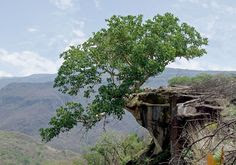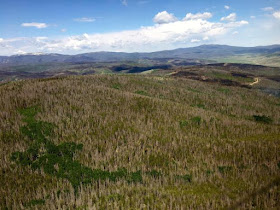A well intentioned Rewilding Movement motivated more by heart felt emotion than real world boots on the ground research based on logic and our present Climate Change reality
 |
| Photo: Craig Kohlruss |
I've previously written about the disaster presently going on in California forests where millions upon millions of dead and dying conifers, oaks and other trees are the result of intense drought exacerbated by Climate Change.
Millions of dead/dying trees have nothing to do with Climate Change ???But now there is word out that some ecology rewilding groups wish to reintroduce the Grizzly Bear back into the state of California again. The state once had a unique California Grizzly bear species, but humans forced it's extinction. I believe the last one was killed somewhere back in the 1920s. Here are some important pertinent quotes from the "Bozeman Daily Chronicle" on potential for rewilding efforts:
"The Center for Biological Diversity has collected some 20,000 signatures on an online petition urging the state Fish and Game Commission to consider studying the feasibility of reintroducing the grizzly, which is listed a federal threatened species."
"The group also is doing social media ads for its campaign in preparation for presenting a formal petition to the commission in a few months."
"Environmentalists call the messages part of a broader national campaign of “rewilding” areas to restore large carnivores such as bears, wolves, badgers and otters and protecting large connected habitats for them."
"Large predators and large habitats, rewilding advocates say, are essential to keeping ecosystems healthy."
(Source)Okay, I get this. I totally understand the reasons and emotions behind the well intentioned idea. But careful forethought and planning need to be done before any rash decision making for reintroduction of the non-native variety of Grizzly Bear into California. I say 'non-native', because the actual unique native California Grizzly has been extinct for almost a century now. Any bears will have to be captured in Idaho, Montana or Wyoming. Just like plant systems, there is unique species specific importance for localized seed when you attempt replanting any disturbed area. It should be no different with wildlife. To their credit, the Center for Biodiversity called for a feasibility study. Frankly, it shouldn't actually take that much time and money to figure out whether or not this could succeed. Follow me below on this, but first, here is another online journal link on the subject from California.
Mercury News: Grizzly bears in California: Reintroduction push ignites strong emotions
What about the eco-green ecosystem reality on the ground in California ???
 |
| (Dan Honda, Bay Area News Group) |
 |
| Image - Matt Dunham/AP |
Even if they could play Jurassic Park Geneticist by reconstructing the DNA of frozen Woolly Mammoths and combining it somehow with the DNA of a living Asian Elephant today, Sci-Fi World aside, if (and that's a big if) they could actually do this, what kind of world would they be bringing these creatures back to ? This planet is ruined and there is hardly enough sustainable wild habitat for even the large animals in Africa anymore. Most likely it would be an artificial Animal Park with the poor animals being fit with radio collars and wearing ear tags. Seriously though, is that what people really what ? Getting back to Grizzlies though. Once again I get all the emotion and heartfelt desires, but they have to be logical about this. These animals will go where there is food and that means people. Already there are conflicts in many places with black bears not being able to forage out in the wild and entering suburban areas. Then there are the issues of available waterways like streams and rivers. Grizzlies love both and need fishing, but that is also in doubt when it comes to California. I never thought I would see this day when California would lose most of it's historical forests.
Major Challenges with Food and Foreaging Natural Resources within California
http://www.cbsnews.com/news/californias-native-salmon-struggling-after-5-years-of-drought
CREDIT: Justin Sullivan/Getty
|
When you think of big brown bears like Grizzlies, what else does this bring to mind ? Salmon runs and fishing. At one time way back in history, the native California Grizzly Bears were King throughout California all the way down into Baja California. Juan Bautista de Anza the Spanish Explorer in 1774 & 76 and Fray Pedro Font who accompanied him on the trek, both wrote about Bears (Los Osos) in their expedition diary journals when they passed through Southern California. Sightings were along water courses like the San Jacinto River in Hemet/San Jacinto Valley. Other sightings were after they had crossed the Santa Ana River and heading west through the I-10 corridor region of Ontario, Pomona & San Dimas. Many rivers flowed year round in those days from the northern canyons of present day Angeles National Forests. The rivers ran full all year and contained large populations of the native and now almost extinct Steelhead Trout or Salmon. Perfect Grizzly habitat in those days as even the forest tree lines were far lower in mountain elevation than they are today. Wetlands, marshes and large scale riparian woodlands were everywhere as well from the descriptive writings of Pedro Font and Juan Bautista de Anza where they often mentioned having to avoid them in many places which required long detours. The next recorded Grizzly sightings were towards Ventura/Santa Basbara, but especially further north in the river floodplain and delta region of the Santa Maria river south of San Luis Obispo where numerous bears gathered for fishing.
Sadly, all these once pristine wild scenes are all barely a memory now. Most of those former rivers and streams are dry sandy rocky washes now. Dams were built way upstream and rainfall now days is almost nothing. Any periodic flooding comes from street runoff and other human industrial infrastructural development. Southern California will never ever again support any Grizzly population, not even a small one. The Sierras are also doubtful as millions upon million of various species of trees die off. Northern California would be the only choice, but it would still have to be large deep isolated wilderness and there is not much of that in a state of millions of humans, even as they move into more rural areas. Plus the Grizzlies would never be content to stay put there, especially with any food resources being almost nill. People are where the food is and that is where the failure of reintroduction would come in.
Grizzlies, Salmon & other wildlife require healthy viable green vegetative ecosystemsI've touched on dead and dying trees by the millions upon millions, but all success hinges on this. For all the wildlife concerned. It's not a matter of replanting. You need healthy normal climate dynamics to return for that and at present this seems unlikely. Much talk is being done to save the dead forest snags from big timber interests and other opposing scientists are in favour of logging anyway to fuel energy plants with wood to reduce coal. The argument being that these trees will burn and pump CO2 in to the atmosphere anyway if they stay put and are later consumed by wildfire. But will just leaving these trees really encourage the forest to return naturally on it's own ? I doubt it. There is a problem with regards where the viable seed will come from. Many of these trees were sick and thristy long before the bark beetles finished the job. When trees are stressed, they pump what little water resources there are into defensive survival mode as opposed to offensive seed production. So it's highly doubtful there was much of a viable wild seed bank out there in many areas where these trees died. If there were cones, then most of the cones would have opened up and released seed when they died and dried out. Any seedlings which may have resulted would most likely never had a chance in the present drought and if made if to sapling stage, then any resulting wildfire cooks that rehab. The much praised and celebrated fire ecology rebirth strategy becomes toast in such dead forest wildfire because there is no viable seed to kickstart the renewal process. Consider that these forests are dying on a massive wholesale scale. Replanting is also another option, but will that succeed ? Not without climate correction to bring back a normal rainfall pattern. This too seems unlikely. Also consider from what sources would the seed for seedlings come from. Most often today from out of state. Specific habitats require seed from those regions. Much failure has been experienced where region specific seed has not been used. This is even true of chaparral restoration projects.
A good example of the importance of site specific species to any region is in several Silver Sagebrush restoration programs. While once I was researching about a native (Giant Palouse Earthworm) of eastern Washington which apparently thrives in native bunch graaslands and Silver Sagebrush Steppes, I stumbled upon the reference to a region where replanted Silver Sagebrush had failed because it was not the specific type of Artemisis to the area. If I can find that reference I'll come back and post it here later. Much of this region has been converted to dryland farming with millions of acres in wheat production. But a reference to habitat restoration of Silver Sagebrush Steppe in this region mentioned failure of Artemisia establishment because the wrong species was used. They all died. Many Silver Sagebrush restoration initiatives have ended in failure because several factors for regeneration have been ignored. And successional management models have identified these as underlying causes of failure as good site availability, species availability, and species performance.
 |
| Image: Northwest Conifers White Pine (Pinus strobus) |
See: (National Park Service - Yellowstone: How Important is Whitebark Pine to Grizzly Bears?)
 |
| Image - U.S. Forest Service Beetle killed trees in Colorado's Never Summer Mountains |
This photo above is from Colorado Rockies where millions of acreage of unhealthy forest trees are also under attack from Bark Beetles. Bears here along with other wildlife are struggling. Does anyone actually believe that California forests would be anymore inviting to a hungry Grizzly ? Frankly, forget the danger to people scenario for a moment. I think it's just as unfair and unkind towards the non-native Grizzly Bears to insert them into such a lousy habitat. It'll be nothing more than eye candy for eco-activists. There is no Quickie Nirvana here folks.
Update: September 12th, 2016
Hungry bears focus on gaining as much fat as possible before winter hibernation
"They become very food obsessed. It's really all around gaining as much fat as possible, right before the winter," said conservationist Kevin Van Tighem.Wonder how desparately food obsessed native Rocky Mountain Grizzlies will be if introduced into non-native degraded habitats in the drought stressed extremes of California ???
CBC NEWS: Grizzly bears in Alberta family's yard were 'food obsessed,' expert says
=======================================
Past Posts where I wrote about historical references to Grizzlies in California
The San Jacinto River Valley that Juan Bautista de Anza saw
San Jacinto River Wildlife Refuge & the wetlands potential beyond to Corona
Anza's Dairy & the Lessons Learned































